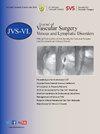下肢继发性淋巴水肿淋巴管吻合术的优化策略
IF 2.8
2区 医学
Q2 PERIPHERAL VASCULAR DISEASE
Journal of vascular surgery. Venous and lymphatic disorders
Pub Date : 2025-01-01
DOI:10.1016/j.jvsv.2024.101984
引用次数: 0
摘要
背景:淋巴管吻合术(LVA)已成为继发性肢体淋巴水肿患者越来越常见的治疗方法。本研究旨在优化使用 LVA 技术治疗下肢继发性淋巴水肿的策略,以提高患者的治疗效果:我们对 2020 年 1 月至 2023 年 12 月期间在浙江省台州医院接受 LVA 的 121 例患者进行了回顾性分析。术前和术后评估包括术中观察、功能参数和临床结果。根据周径缩小、生活质量改善(LYMQoL问卷)和术后并发症评估LVA的疗效:该研究共纳入了121名下肢淋巴水肿患者,平均年龄为58.19岁。结果显示,切口深度、淋巴管大小、进行 LVA 的次数以及每位患者的切口数量与术后体积缩小之间存在明显关联。分析结果表明,最佳切口深度为 10-15 毫米,淋巴管大小为 0.4-0.6 毫米,建议进行 6-8 次 LVA。LVA 术后,患者的生活质量明显改善,尤其是在功能和外观方面:这项研究结果优化了 LVA 手术的策略,建议使用切口深度、淋巴管大小和吻合次数来改善下肢继发性淋巴水肿患者的生活质量和肢体体积。本文章由计算机程序翻译,如有差异,请以英文原文为准。
Optimizing strategies for lymphaticovenular anastomosis in lower secondary extremity lymphedema
Background
Lymphovenous anastomosis (LVA) has become an increasingly common treatment for patients with secondary extremity lymphedema. The objective of this study was to optimize strategies for lower secondary extremity lymphedema using LVA techniques, with the aim of enhancing patient outcomes.
Methods
We conducted a retrospective analysis of 121 patients who underwent LVA at Taizhou Hospital of Zhejiang Province from January 2020 to December 2023. Preoperative and postoperative assessments included intraoperative observations, functional parameters, and clinical outcomes. The efficacy of LVA was evaluated based on circumferential reduction, quality of life improvements (Lymphoedema Quality of Life Questionnaire), and postoperative complications.
Results
This study enrolled 121 patients with lower secondary extremity lymphedema, with an average age of 58.19 years. The results revealed significant associations between incision depth, lymphatic vessel size, the number of LVAs performed, and the number of incisions per patient, all of which correlated with postoperative volume reduction. The resulted analysis that identified optimal incision depths of 10 to 15 mm, lymphatic vessel size of 0.4 to 0.6 mm, and a recommended number of 6 to 8 LVAs. After LVA, there was a marked improvement in patient quality of life, with particularly notable enhancements in functionality and appearance.
Conclusions
This study’s findings optimizing the strategy for LVA surgery recommend the depth of incision, the size of lymphatic vessels, and the number of anastomoses to improve the quality of life and limb volume in patients with secondary lymphedema of the lower limbs.
求助全文
通过发布文献求助,成功后即可免费获取论文全文。
去求助
来源期刊

Journal of vascular surgery. Venous and lymphatic disorders
SURGERYPERIPHERAL VASCULAR DISEASE&n-PERIPHERAL VASCULAR DISEASE
CiteScore
6.30
自引率
18.80%
发文量
328
审稿时长
71 days
期刊介绍:
Journal of Vascular Surgery: Venous and Lymphatic Disorders is one of a series of specialist journals launched by the Journal of Vascular Surgery. It aims to be the premier international Journal of medical, endovascular and surgical management of venous and lymphatic disorders. It publishes high quality clinical, research, case reports, techniques, and practice manuscripts related to all aspects of venous and lymphatic disorders, including malformations and wound care, with an emphasis on the practicing clinician. The journal seeks to provide novel and timely information to vascular surgeons, interventionalists, phlebologists, wound care specialists, and allied health professionals who treat patients presenting with vascular and lymphatic disorders. As the official publication of The Society for Vascular Surgery and the American Venous Forum, the Journal will publish, after peer review, selected papers presented at the annual meeting of these organizations and affiliated vascular societies, as well as original articles from members and non-members.
 求助内容:
求助内容: 应助结果提醒方式:
应助结果提醒方式:


